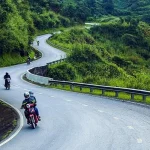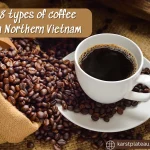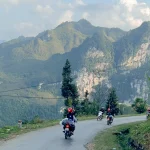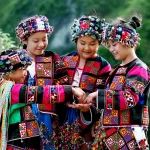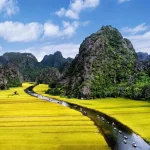Fansipan Mountain, often hailed as the “Roof of Indochina,” stands proudly as the highest peak in Vietnam, reaching an impressive 3,147 meters (10,326 feet) above sea level. Located in the Hoang Lien Son mountain range in northern Vietnam. This majestic peak, known for its breathtaking landscapes and challenging trails, provides an unforgettable experience that combines natural beauty, cultural richness, and personal achievement. In this guide, let’s Karst Plateau explore the allure of Fansipan Mountain.
1. How to Access Fansipan Mountain

This incredible natural wonder not only offers breathtaking views but also a myriad of experiences that attract adventurers, nature lovers, and cultural enthusiasts alike
To access Fansipan Mountain, there are primarily two methods: trekking or using the cable car, each offering unique experiences. For those who are physically capable and adventurous, trekking provides an immersive experience with nature, while the cable car presents a more leisurely route to the summit.
Trekking is a thrilling way to explore the diverse flora and fauna, captivating landscapes, and hidden gems dotted along the trails. The physical challenge of hiking to the peak becomes rewarding as each step unveils new vistas, providing hikers with a chance to connect deeply with the environment.
On the other hand, the cable car experience is perfect for families or those who may not wish to endure a strenuous hike. It allows visitors to appreciate the breathtaking scenery without exerting themselves physically. Both methods culminate at the same point – the summit of Fansipan – where the beauty of nature converges in a spectacular panorama.
1.1 Trekking Routes to Fansipan Mountain
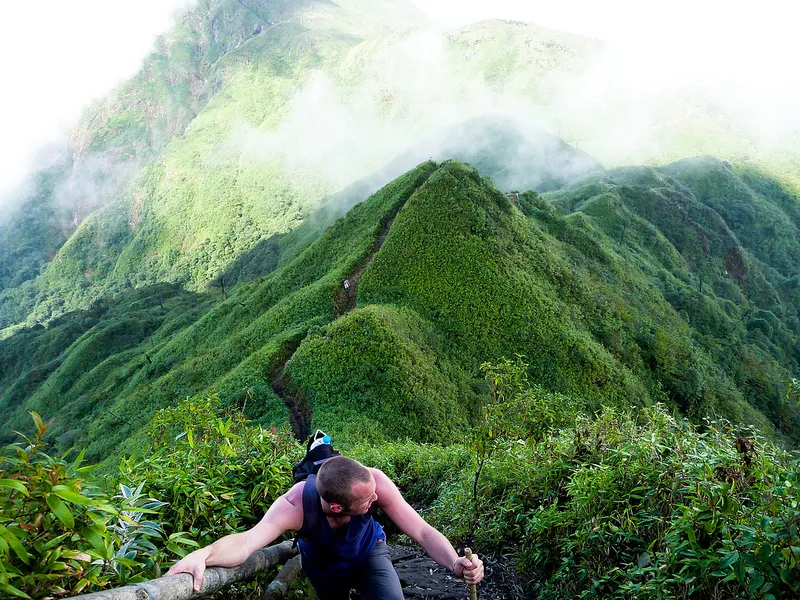
Fansipan offers an unparalleled adventure for trekkers and nature enthusiasts alike
For trekking enthusiasts, Fansipan offers three distinct routes, each varying in difficulty: the Tram Ton Route, the Sin Chai – Tram Ton Route, and the Cat Cat Village Route.
Tram Ton Route (Easiest):
- Starting Point: Tram Ton, at an elevation of 1,900 meters.
- Experience: This route is ideal for beginners, taking approximately 6-7 hours to reach the summit.
- Scenery: While slightly less dramatic than other paths, it showcases gentle slopes and sprawling greenery, making it accessible for those in moderate shape, yet still rewarding in its views.
Sin Chai – Tram Ton Route (Medium Difficulty):
- Starting Point: Sin Chai.
- Experience: This route is best suited for those with some prior hiking experience.
- Scenery: Hikers will be greeted with more challenging terrain and spectacular views, elevating the journey into an enticing adventure.
Cat Cat Village Route (Highest Difficulty):
- Starting Point: Cat Cat Village.
- Experience: Tailored for experienced hikers, this rigorous trek can take up to two days and encompasses steep climbs and serene nature trails.
- Scenery: Offers the most diverse sights, immersing trekkers in the region’s flora and fauna, especially as they encounter picturesque viewpoints and exotic wildlife.
Depending on your fitness level and adventure desires, each route offers its own prizes, encapsulating the essence of what it means to conquer Vietnam’s highest peak.
1.2 Cable Car Experience
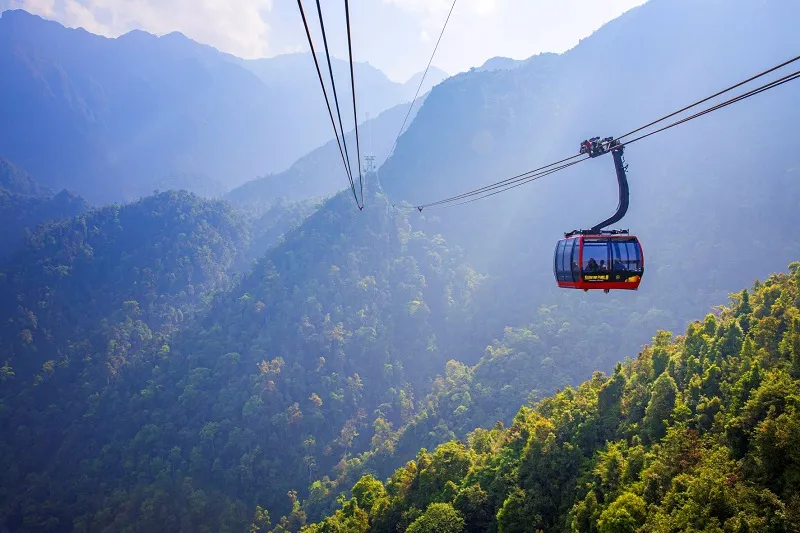
The combination of magnificent views and a smooth ride makes the cable car a compelling option for visitors of all ages
For those who prefer a more relaxed approach, the Fansipan cable car provides an unforgettable experience without the physical exertion. Here are the highlights of this modern attraction:
- Opening Hours: The cable car operates daily, with slightly extended hours on weekends. Typically, it runs from 08:30 AM to 05:00 PM on weekdays and from 07:30 AM to 05:30 PM on weekends.
- Journey Duration: The ascent takes approximately 15-20 minutes, during which passengers are treated to sweeping views of the surrounding Hoang Lien Son mountain range.
- Ticket Prices: As of 2024, ticket prices are around 800,000 VND (approximately $35) for adults. For children between 1.1 meters and 1.4 meters, the cost is about 550,000 VND (approximately $25).
- Transport Capacity: The cable car system has an impressive capacity, accommodating about 2,000 passengers per hour across its 33 cabins, with each cabin holding up to 35 people. This efficiency ensures minimal wait times and a swift journey to the summit.
The combination of magnificent views and a smooth ride makes the cable car a compelling option for visitors of all ages. It enhances the overall experience of visiting Fansipan Mountain, especially for families or those who may not be prepared for the demands of a trek.
1.3 Muong Hoa Funicular Train
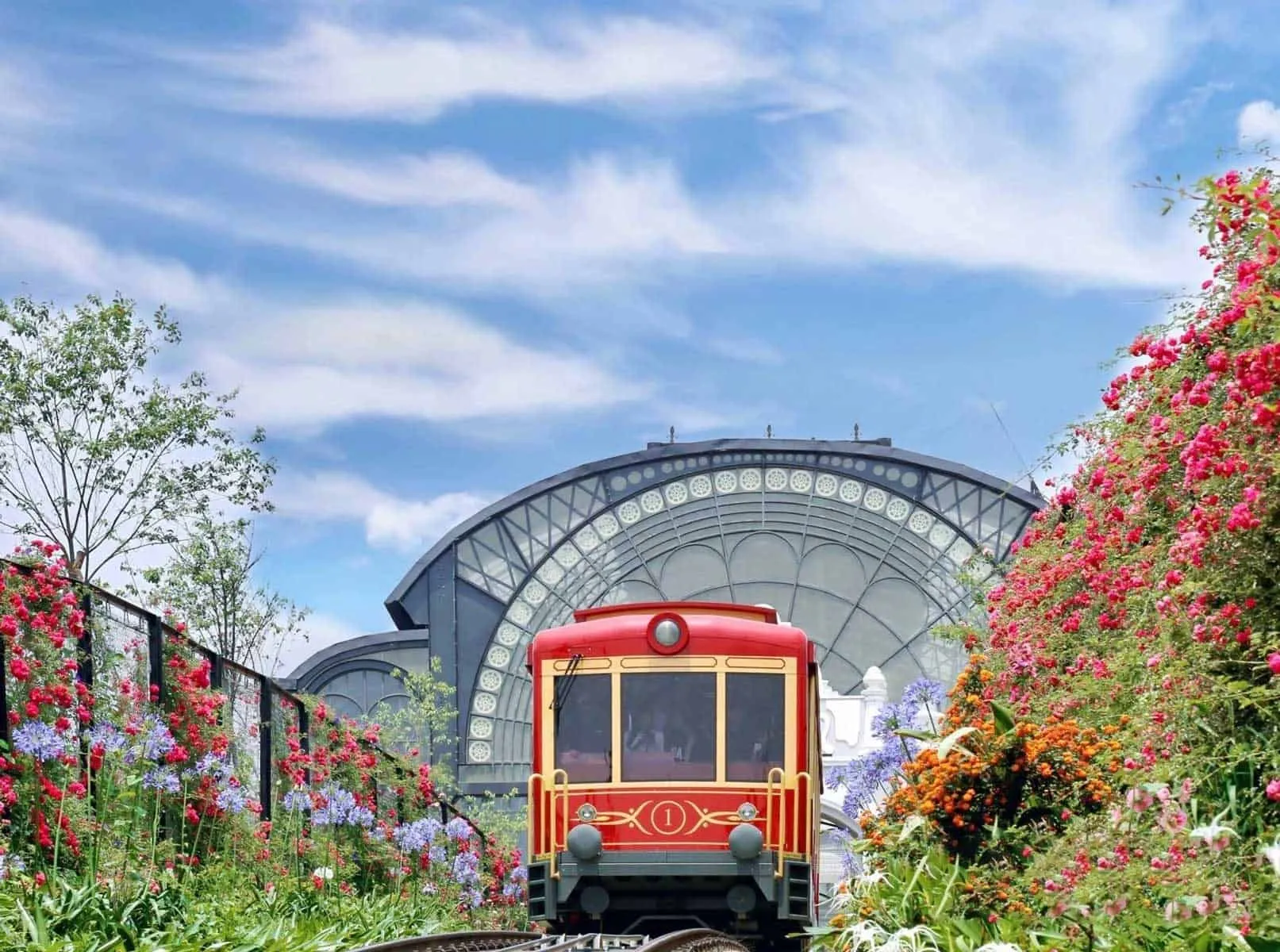
The Muong Hoa Funicular Train offers an extraordinary journey through one of the country’s most picturesque terrains
In addition to trekking or taking the cable car, another unique option for accessing Fansipan is the Muong Hoa Funicular Train. This charming ride brings visitors through the stunning Muong Hoa Valley, known for its impressive terraced rice fields and natural beauty.
Starting Point: Visitors typically begin their journey in Sapa town and make their way to Muong Hoa Valley.
Ticket Price: Tickets for a round trip on the funicular cost approximately 150,000 VND (around $6.30 USD).
Scenic Experience: The funicular offers an enjoyable and scenic ascent, allowing passengers to take in the breathtaking landscapes as they glide smoothly toward the cable car station.
Connection to Cable Car: After disembarking from the funicular, visitors will need to purchase tickets for the cable car (approximately 800,000 VND for adults and 550,000 VND for children) to reach the summit.
The combination of the funicular ride followed by the cable car allows for a scenic, diverse experience of Fansipan Mountain that is accessible to a wider audience.
2. Best Time to Visit Fansipan Mountain
The ideal time to visit Fansipan Mountain significantly depends on the type of experience and activities one wishes to enjoy. Here’s a breakdown of what each season offers, helping travelers plan their visit effectively.
2.1 Spring Season Highlights
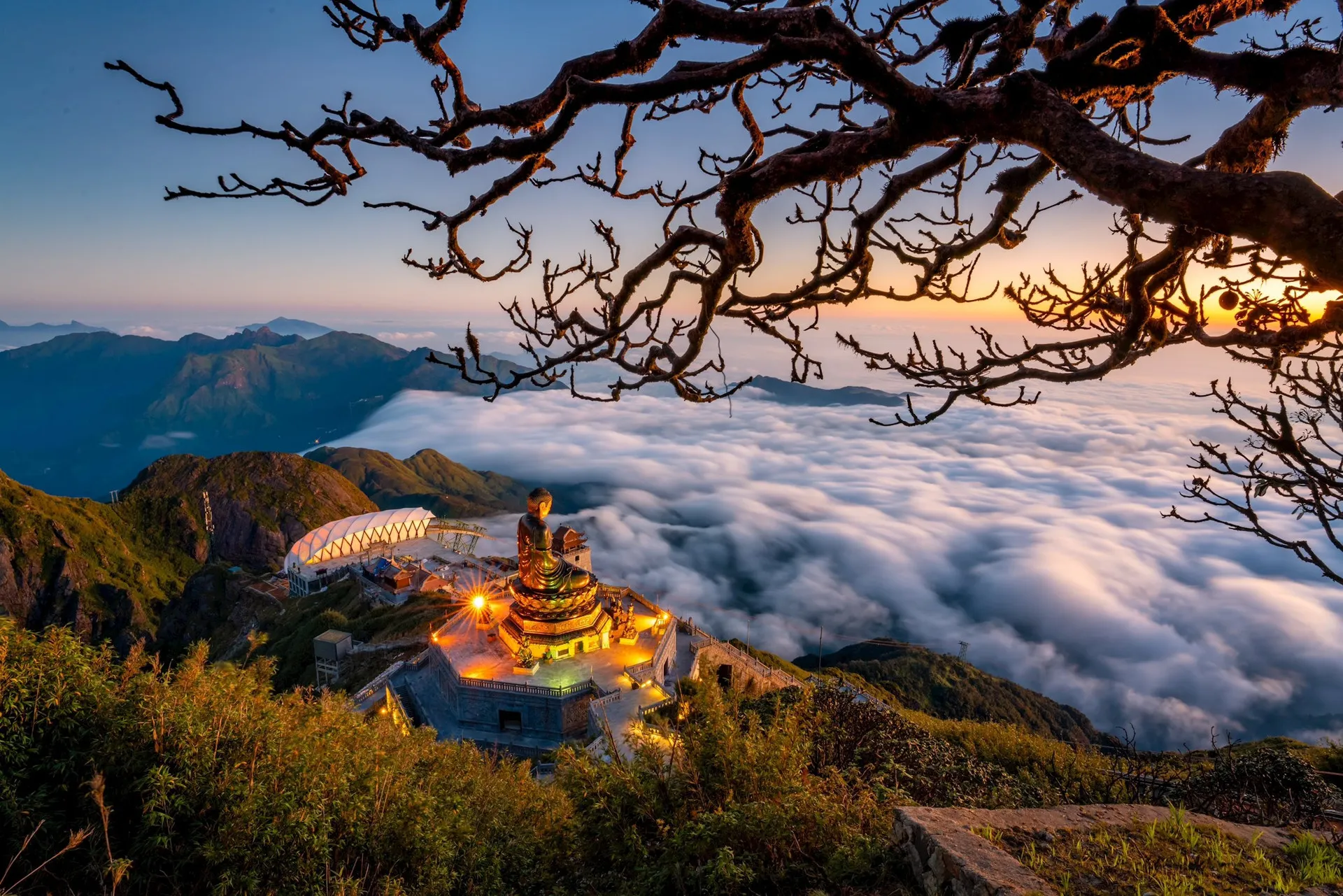
Spring is undoubtedly one of the best times to visit Fansipan Mountain
Spring, particularly from March to May, is undoubtedly one of the best times to visit Fansipan Mountain. The weather is mild, and visitors can enjoy the blossoming of vibrant flora, including rhododendrons and peach blossoms.
Mild Weather: The temperatures during spring average between 15°C and 25°C (59°F to 77°F), providing comfortable conditions for outdoor activities.
Floral Displays: The surrounding landscape flourishes with blooming flowers that create a stunning backdrop for any adventure, and these vibrant colors are a delight for photographers.
Cultural Events: Spring festivals in Sapa coincide with this season, offering visitors the chance to engage in local traditions, festivities, and authentic Sapa cuisine.
Overall, spring in Fansipan Mountain is an enchanting experience filled with beauty and cultural richness.
2.2 Summer Activities and Weather

Summer is a favorable time for those seeking dynamic natural beauty
During the summer months of June through August, Fansipan experiences a shift in characteristics. While it can be humid with frequent rainfall, this season offers lush greenery.
Temperature: In valleys, temperatures hover between 15°C and 30°C (59°F to 86°F)
Lush Landscapes: The abundant moisture supports the growth of vibrant flora, making it ideal for trekking enthusiasts intent on exploring scenic trails.
Photography Opportunities: Summer is prime time for capturing breathtaking views of thriving landscapes
Despite occasional thunderstorms, summer remains a favorable time for those seeking dynamic natural beauty.
2.3 Autumn Scenery and Events
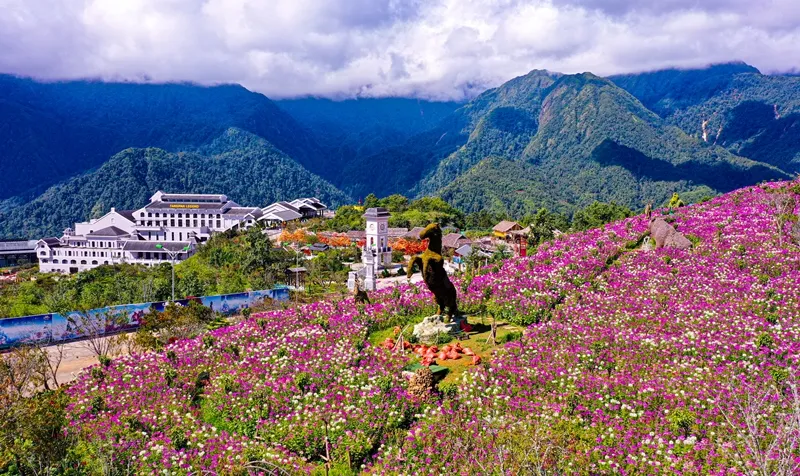
The beauty of autumn makes it one of the most sought-after times to visit the mountain
From September to November, autumn presents a chartered shift in the environment with cooler temperatures and stunning changing landscapes.
Temperatures: The temperature typically ranges from 10°C to 25°C (50°F to 77°F), creating perfect conditions for outdoor activities.
Harvest Festivals: This season coincides with rice harvests, leading to local celebrations and cultural events, showcasing music, dance, and traditional food.
Scenic Views: The cooler weather provides clear skies, ideal for trekking and sightseeing, leading to unforgettable vistas of golden rice fields against the backdrop of Fansipan.
2.4 Winter Experiences
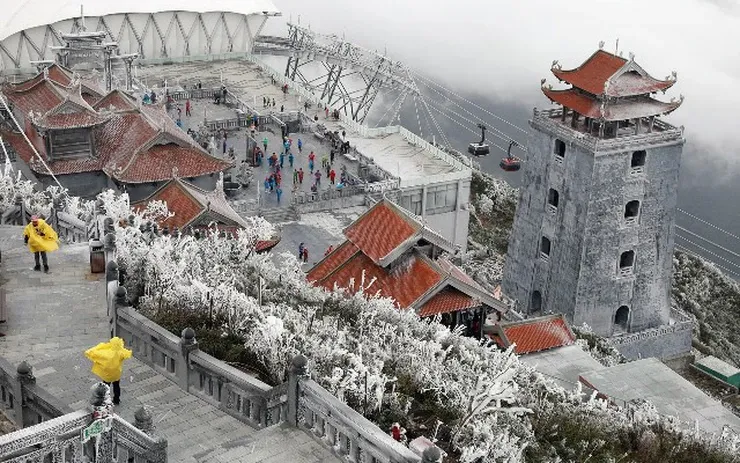
While snowfall is rare, it can happen at higher elevations
The winter months from December through February bring colder temperatures to Fansipan Mountain. Daytime highs average around 7°C (45°F), and while snowfall is rare, it can happen at higher elevations.
Chilly Conditions: Visitors can expect freezing temperatures, especially at night, necessitating warm clothing and proper gear.
Unique Aesthetic: The stillness of winter lends serene beauty to Fansipan, with misty landscapes creating a mystical atmosphere ideal for winter photography.
Each season at Fansipan offers its unique beauty, making the mountain a year-round destination for all types of travelers.
See More: Top 7 most popular Sapa tourist destinations in 2024
3. What to Expect at the Summit
Upon reaching the summit of Fansipan Mountain, adventurers are met with an array of experiences that make their journey worthwhile. From stunning panoramic views to cultural and spiritual sites, the peak serves as a remarkable destination.
3.1 Panoramic Views from the Peak
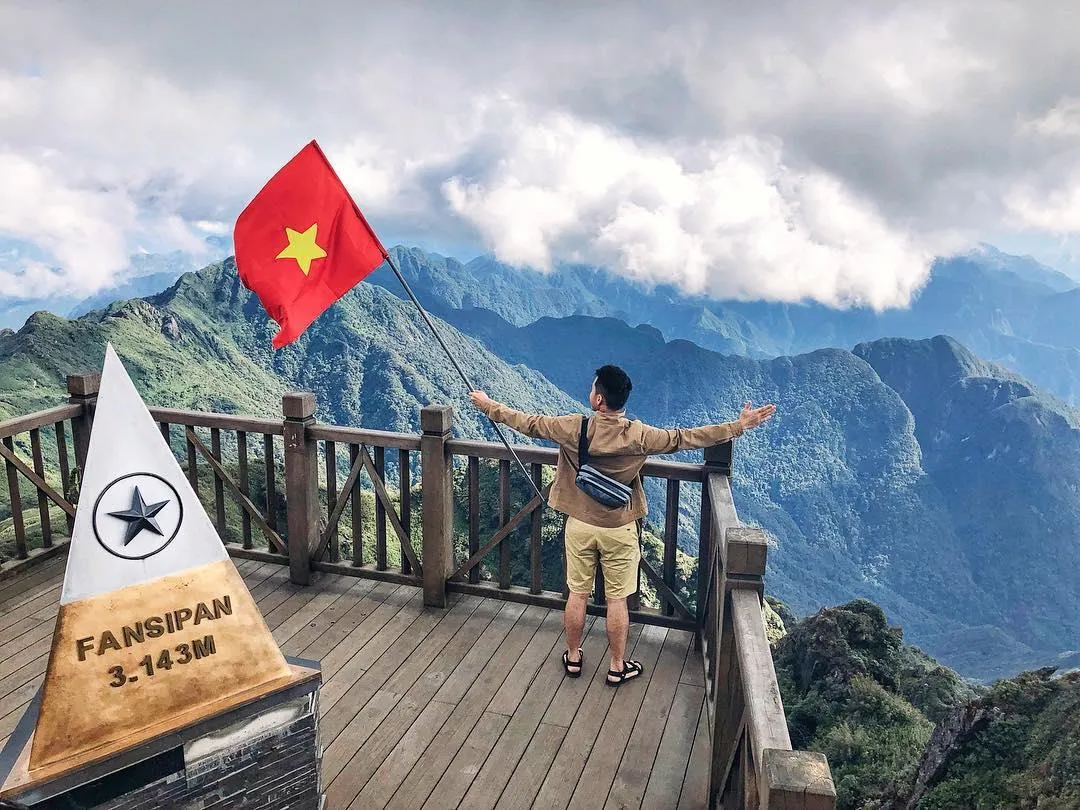
Visitors can lose themselves in the mesmerizing beauty that unfolds at each moment as they stand amid clouds
The summit of Fansipan boasts enchanting panoramic views that stretch infinitely across the distant valleys and peaks of the Hoang Lien Son range.
Stunning Vistas: At an elevation of 3,147 meters, trekkers are rewarded with breathtaking scenes where the ebb and flow of mist and clouds create constantly changing landscapes.
Ideal Photography Locations: The peak is an ideal photography spot, encouraging visitors to capture the extraordinary beauty surrounding them as they stand atop the highest mountain in Vietnam.
Sense of Accomplishment: Achieving the summit provides a profound sense of accomplishment, creating memories that last a lifetime and a deep connection to the natural world.
Visitors can lose themselves in the mesmerizing beauty that unfolds at each moment as they stand amid clouds, feeling both on top of the world and deeply connected to the earth below.
3.2 Cultural and Spiritual Sites
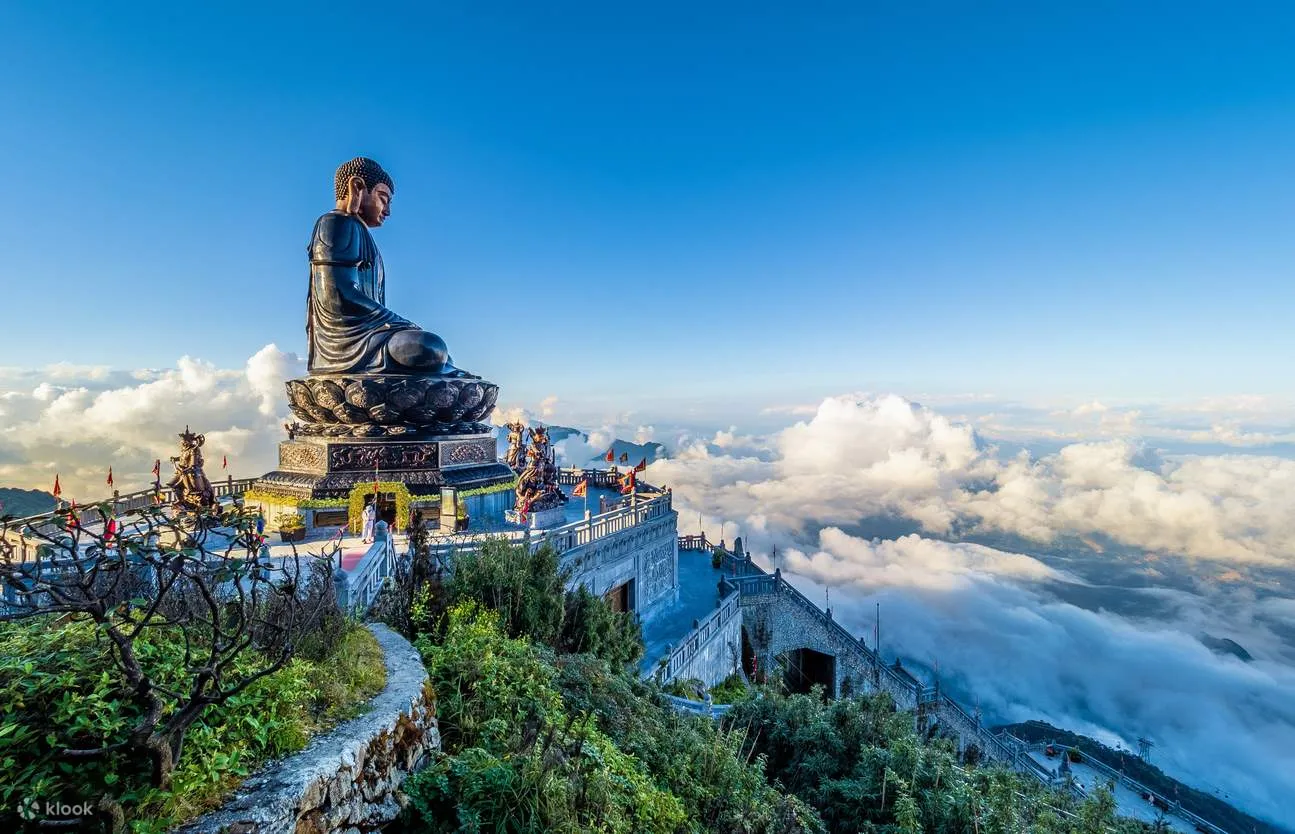
The combination of natural beauty and cultural depth makes the summit a profound experience for each visitor
Fansipan’s summit is more than just a viewpoint; it is also home to culturally significant and spiritually enriching sites, making it a holistic destination for travelers.
The Amitabha Buddha Statue: Standing at an impressive height of 21.5 meters, this monumental statue is one of the tallest bronze Buddha statues in Asia.
Bich Van Zen Monastery: Close to the summit, this peaceful monastery reflects traditional Vietnamese architecture, providing visitors with a serene place for prayer and meditation.
Celestial Gardens and Pagodas: These areas, adorned with sculptures and flora, open a space for personal introspection and reverence, accentuating the spiritual significance of Fansipan Mountain.
The combination of natural beauty and cultural depth makes the summit a profound experience for each visitor.
3.3 Hiking Challenges and Accomplishments
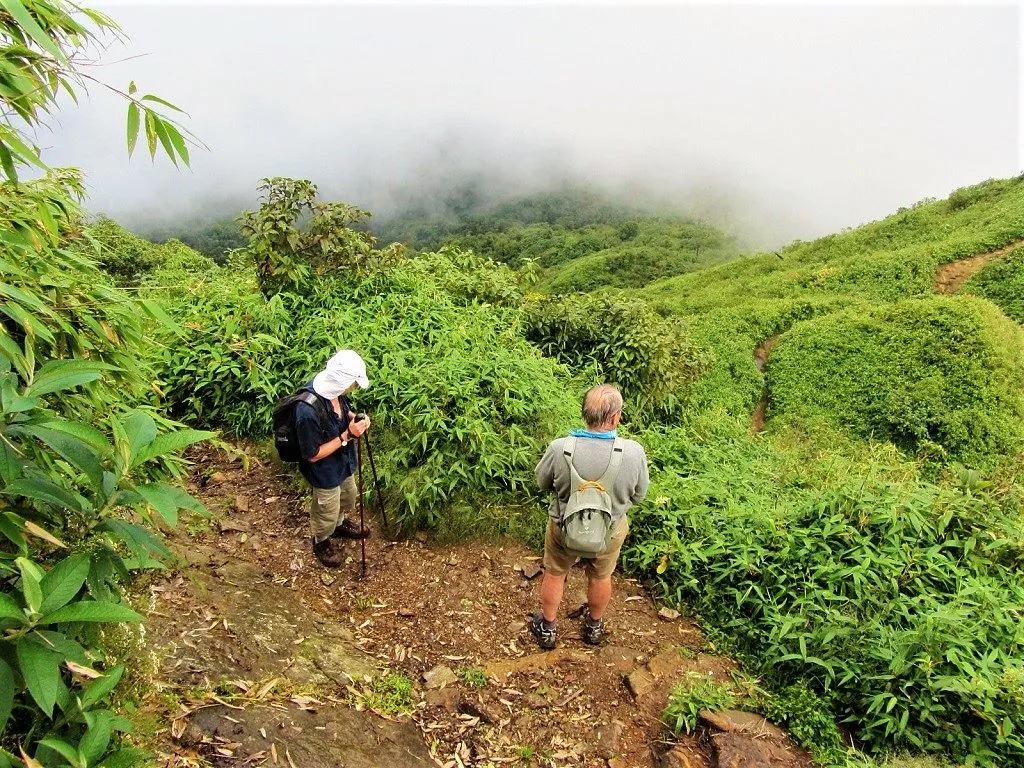
Understanding the challenges enhances appreciation for the journey taken to reach Vietnam’s highest point
Reaching the summit of Fansipan Mountain is not without its challenges, but the sense of achievement felt upon completion is monumental.
Trail Navigation: Hikers can expect diverse terrains and varying levels of difficulty as they navigate the paths leading to the summit.
Physical Challenges: The high altitude and steep ascents can be demanding; thus, hiking Fansipan Mountain is a true test of endurance.
Celebratory Moments: Once at the peak, the sense of achievement is palpable, creating a perfect moment for reflection, photography, and celebration with fellow hikers.
4. Recommended Activities Around Fansipan
Beyond the summit, the surrounding region offers various activities that enrich the overall Fansipan Mountain experience.
4.1 Cultural Experiences with Local Ethnic Groups
Visitors have the opportunity to connect with local ethnic minority groups, including the Black Hmong and Red Dao, engaging in meaningful cultural exchanges.
Homestays: Staying with local families provides insight into their daily lives, culture, and traditions, allowing visitors to witness firsthand the vibrant activities and hospitality of the local communities.
Craft Workshops: Visitors can participate in workshops to learn traditional crafts such as weaving, basket-making, and gardening practices.
4.2 Photography Opportunities
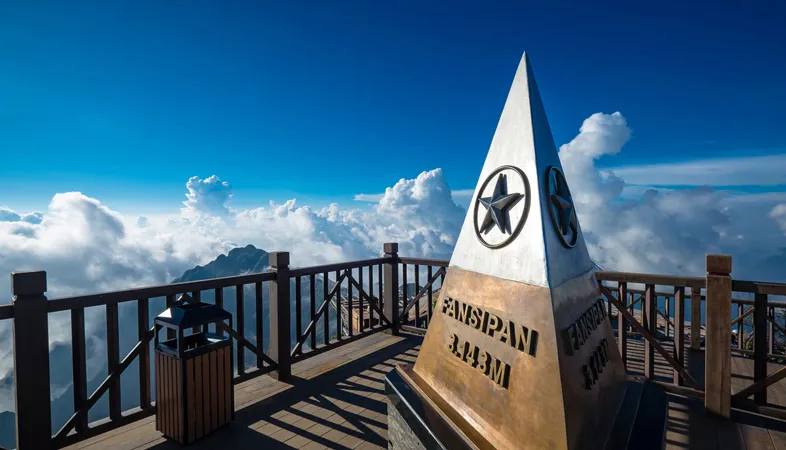
The combination of stunning landscapes and rich cultural experiences makes Fansipan Mountain a paradise for photographers
Fansipan Mountain provides countless photography opportunities for enthusiasts seeking to capture remarkable moments.
Natural Landscapes: The diverse ecosystems, terraced rice paddies, and scenic mountain vistas are ideal for nature photography, allowing photographers to encapsulate the breathtaking beauty of the region.
Sunrise and Sunset Photography: The unique lighting conditions during dawn and dusk create magical atmospheres, making it a perfect time for capturing stunning images.
Potpourri of Cultures: Documenting local traditions, festivals, and markets provides photographers with a rich tapestry to document and share.
The combination of stunning landscapes and rich cultural experiences makes Fansipan Mountain a paradise for photographers.
4.3 Gastronomic Delights in Sapa
Sapa’s culinary scene complements the scenic beauty of Fansipan Mountain and offers visitors a diverse array of dishes to try.
Local Cuisine: Dishes such as ‘Thang Co‘, a traditional horse meat meal, and ‘Com Lam‘, arboreal rice, are must-try specialties encountered in local eateries.
Street Food Markets: The Sapa Night Market presents a vibrant atmosphere, where food stalls boast delicious street foods like grilled corn and local sausages, providing a true taste of the region.
Restaurants and Cafés: Places like Viet Emotion offer delightful menus that feature both Vietnamese and Western cuisines, along with stunning views that enhance meal experiences.
Exploring the culinary delights adds a rich layer to any visit, enhancing the journey through Fansipan Mountain and Sapa.
5. Essential Tips for Climbing Fansipan
To ensure a safe and enjoyable climbing experience at Fansipan Mountain, it is vital to consider essential tips and prepare adequately.
5.1 Physical Preparation and Gear
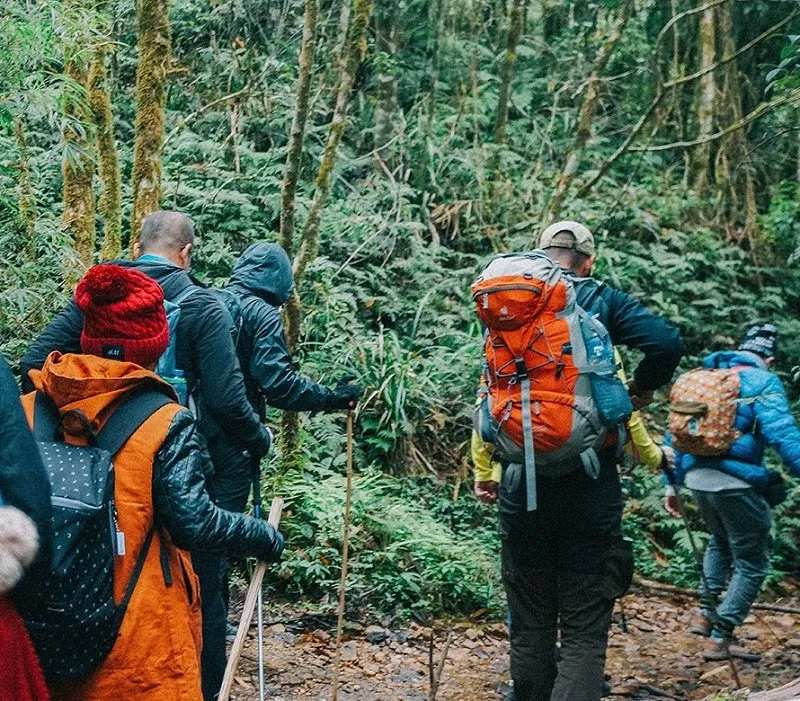
These preparations will enable you to face the mountain with confidence
Fitness Level: Engage in regular exercise to build stamina leading up to the hike. Whether it’s EMS training, running, or climbing lesser peaks, prepare your body for the demands of the ascent.
Hiking Practice: Get accustomed to various terrains by practicing on different trails leading up to Fansipan Mountain, helping you acclimate to the unique challenges faced at the peak.
Proper Gear: Invest in quality hiking boots, weather-appropriate clothing, a daypack, navigation tools, and safety items like first aid kits and multi-tools; ensure they are all in good condition before your journey.
These preparations will enable you to face the mountain with confidence.
5.2 Safety Guidelines
Hire a Guide: Engaging the services of a local guide enhances safety and enriches the experience, as they can provide valuable information about the terrain and cultural insights that only locals can share.
Group Travel: Traveling in groups fosters a safer environment for hiking. Establish communication points and backtrack plans should members become separated.
Emergency Preparedness: Be aware of emergency processes, such as knowing the nearest medical facilities, how to use navigation tools and symptoms of altitude sickness.
Following these safety measures ensures a well-rounded experience.
5.3 Weather Considerations

Being informed about weather factors enhances your climbing experience
Monitor Weather: Before hiking, check forecasts to ensure favorable conditions are anticipated. Weather on Fansipan can shift rapidly, and being informed helps to make safe decisions.
Seasonal Variations: Be mindful of specific requirements that come with different seasons. For example, the spring may require lighter clothing, while winter will demand insulating gear.
Acclimatization: Spend adequate time at lower elevations before climbing, allowing your body to adjust to higher altitudes. This will help alleviate the effects of altitude sickness. Being informed about weather factors enhances your climbing experience.
Fansipan Mountain stands as a testament to Vietnam’s natural beauty and rich cultural heritage. Whether you choose to ascend its heights through trekking, the cable car, or the funicular train, each method brings unique encounters and breathtaking views. With seasonal charm, diverse activities, adventurous challenges, and cultural immersion, Fansipan Mountain offers unforgettable memories waiting to unfold. Prepare adequately, embrace the journey, and make the most of the experiences awaiting you at the highest peak in Vietnam. Your adventure at Fansipan Mountain is just a step away dare to reach for the sky! For more information and tips on exploring Vietnam’s natural wonders, visit Karst Plateau.

